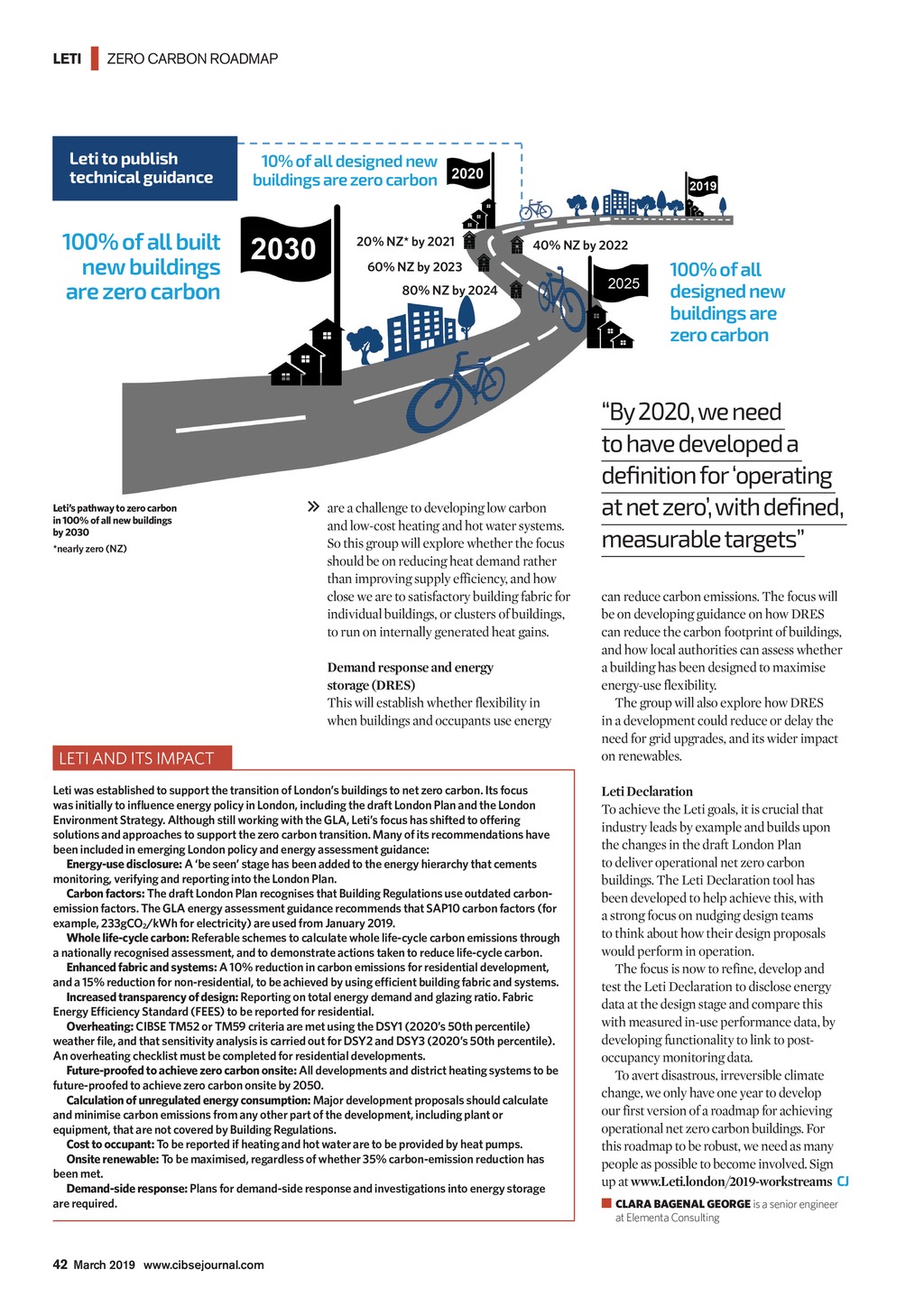




LETI | ZERO CARBON ROADMAP Leti to publish technical guidance 10% of all designed new buildings are zero carbon 100% of all built new buildings are zero carbon Letis pathway to zero carbon in 100% of all new buildings by 2030 *nearly zero (NZ) 20% NZ* by 2021 40% NZ by 2022 60% NZ by 2023 80% NZ by 2024 are a challenge to developing low carbon and low-cost heating and hot water systems. So this group will explore whether the focus should be on reducing heat demand rather than improvingsupply efficiency, and how close we are to satisfactory building fabric for individual buildings, or clusters of buildings, to run on internally generated heat gains. Demand response and energy storage(DRES) This will establish whether flexibility in when buildings and occupants use energy LETI AND ITS IMPACT Leti was established to support the transition of Londons buildings to net zero carbon. Its focus was initially to influence energy policy in London, including the draft London Plan and the London Environment Strategy. Although still working with the GLA, Letis focus has shifted to offering solutions and approaches to support the zero carbon transition. Many of its recommendations have been included in emerging London policy and energy assessment guidance: Energy-use disclosure: A be seen stage has been added to the energy hierarchy that cements monitoring, verifying and reporting into the London Plan. Carbon factors: The draft London Plan recognises that Building Regulations use outdated carbonemission factors. The GLA energy assessment guidance recommends that SAP10 carbon factors (for example, 233gCO2/kWh for electricity) are used from January 2019. Whole life-cycle carbon: Referable schemes to calculate whole life-cycle carbon emissions through a nationally recognised assessment, and to demonstrate actions taken to reduce life-cycle carbon. Enhanced fabric and systems: A 10% reduction in carbon emissions for residential development, and a 15% reduction for non-residential, to be achieved by using efficient building fabric and systems. Increased transparency of design: Reporting on total energy demand and glazing ratio. Fabric Energy Efficiency Standard (FEES) to be reported for residential. Overheating: CIBSE TM52 or TM59 criteria are met using the DSY1 (2020s 50th percentile) weather file, and that sensitivity analysis is carried out for DSY2 and DSY3 (2020s 50th percentile). An overheating checklist must be completed for residential developments. Future-proofed to achieve zero carbon onsite: All developments and district heating systems to be future-proofed to achieve zero carbon onsite by 2050. Calculation of unregulated energy consumption: Major development proposals should calculate and minimise carbon emissions from any other part of the development, including plant or equipment, that are not covered by Building Regulations. Cost to occupant: To be reported if heating and hot water are to be provided by heat pumps. Onsite renewable: To be maximised, regardless of whether 35% carbon-emission reduction has been met. Demand-side response: Plans for demand-side response and investigations into energy storage are required. 100% of all designed new buildings are zero carbon By 2020, we need to have developed a definition for operating at net zero, with defined, measurable targets can reduce carbon emissions. The focus will be on developing guidance on how DRES can reduce the carbon footprint of buildings, and how local authorities can assess whether a building has been designed to maximise energy-use flexibility. The group will also explore how DRES in adevelopment could reduce or delay the need for grid upgrades, and its wider impact on renewables. Leti Declaration To achieve the Leti goals, it is crucial that industry leads by example and builds upon the changes in the draft London Plan to deliver operational net zero carbon buildings. The Leti Declaration tool has been developedto help achieve this, with a strong focus on nudging design teams to think abouthow their design proposals wouldperform in operation. The focus is now to refine, develop and test the Leti Declaration to disclose energy data at the design stage and compare this with measured in-use performance data, by developing functionality to link to postoccupancy monitoring data. To avert disastrous, irreversible climate change, we only have one year to develop our first version of a roadmap for achieving operational net zero carbon buildings. For this roadmap to be robust, we need as many people as possible to become involved. Sign up at www.Leti.london/2019-workstreams CJ CLARA BAGENAL GEORGE is a senior engineer atElementa Consulting 42 March 2019 www.cibsejournal.com CIBSE Mar19 pp40-42 Leti roadmap.indd 42 22/02/2019 16:40